
Bang. Blown away I was by Ed Mazria’s keynote speech at Net Zero 19, the world’s largest net zero conference. This year it was at the Los Angeles Convention Center, hosted again by the Verdical Group and its founder, the highly positive and magnetic chief Drew Shula. A highlight for me was Ed Mazria’s keynote. The founder and CEO of Architecture 2030, Mazria is unassuming, dressed in casual but solid black. A legend he is to me; I still have his classic book on solar energy and design – one of my college texts — in my library.
Ed’s message was all about buildings and meeting the climate challenge. He’s got a slide show reminiscent of the Inconvenient Truth: The world has a decade to react effectively to the climate emergency, and to keep average global temperatures below the 1/5 degrees C specified in the Paris Accord. To do so, according to the United Nations 2018 Emissions Gap Report, globally, we’ll need 55% reduction in total greenhouse gases by 2030.
Mazria spoke of emissions budgets, and the odds of meeting the 1.5 degree goal, a level that allows for reversibility and a return to climate normalcy. The challenge is large: The existing global building floor area of 2.4 trillion square feet is slated to double by 2030. And most development is projected in the Southern Hemisphere, in areas with lax building codes if any. Thus, we need a worldwide building code, he stated, a net zero carbon code.
Mazria is working with industry leaders around the world to push his “zero code standard.” It’s attainable he stressed. The Zero Code is achievable… through efficiency, on and off-site renewables. He sees only minor changes needed for California’s existing building code (Title 24). And his message is getting buy-in: The EU has created its “near-zero” code that applies to all new buildings. China has developed a voluntary zero code. Mazria says that now it’s all about California. The world is following California. There needs to be an executive order. “Make it happen here, and it will happen worldwide!”
Clearly building codes for new construction need to be complemented by retrofits of the existing stock. Mazria made graphically clear that we won’t meet our climate commitments within digging into existing buildings. Each year only 1 – 2 % of the building stock turns over. We need to tackle the existing building stock, and fast.
So where to focus? Big buildings create a disproportionate share of emissions. In Seattle, 2% of the buildings emit 45% of the emissions. Same in New York where the top 2% are over 50,000 square feet. There are a small number of buildings to target right away and to cut their emissions by 65% by 2030…. on their way to being 100% carbon-free by 2050. We need policies and incentives to drive this.
“The elephant in the room” is that of embedded carbon in building materials. There are hundreds of choices of building materials. Mazria states that we must build with low-carbon sources. “Concrete is the most destructive material on the planet,” he stated. “Steel is next in the cross hairs.” Mass timber, on the other hand, is carbon positive as trees have sequestered carbon. There are new products, like concrete made of CO2 and other forms of bio-masonry that we must refine and adopt. Designs, materials, and systems enable net positive building for the future. Imagine that new high rises in India – and all new construction worldwide — could actually be part of the solution to the climate emergency.
Historically Low-Cost Solar + Storage
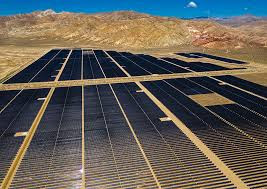
The Los Angeles Department of Water and Power is leading the charge to a clean and green future. Earlier this month, its Commissioners approved a 400 MW solar + 300 MW/1,200 MWh battery storage power plant. Through a Power Purchase Agreement (PPA), the utility will buy the power from the Eland Solar and Storage Center in Kern County (70 miles north) for 25 years, helping the city reach its carbon neutrality goal by 2045.
What’s most phenomenal about the project is its price: Selected by LADWP from a pool of 130 proposals, the solar price is a remarkably low 2 cents/kWh. The combined solar + storage price is 3.3 cents/kWh, less than the cost of a gas plant. The plant is being developed in two phases by 8minutenergy and is expected to be on line by end of 2023.
Particularly challenging in finalizing the deal were unions, notably IBEW Local 18 led by its Business Manager Brian D’Arcy, still stinging from Mayor Garcetti’s announced closure of three natural gas plants in the Los Angeles Basin. To garner union approval, 8minutenergy signed a project labor agreement with IBEW Local 328 in Kern County. Eland will create 700 jobs over 14-month construction period.
Currently, LADWP gets 31% of its energy from renewables. Eland will contribute another 7.1%. LADWP has targets of 55% renewable by 2025 and 80% by 2036. It will be completely divested of coal by 2025. In related news, LADWP has increased its budget for EV charging infrastructure and has tripled its rebates for the purchase of Used EVs, from $450 to up to $1,500 per Used EV.
Walmart and Community Gardens

Walmart has announced that it will buy solar power from every one of U.S. Solar’s 36, 1 MW community gardens in Minnesota. The power will support Walmart operations in 13 Minnesota counties. Through Community Solar, a consumer such as Walmart gets a bill credit based on the amount of energy produced each month by his or her subscribed portion of the solar gardens. The bill credits are based on Minnesota’s Value of Solar methodology which accounts for the value of solar to the utility plus other grid and environmental benefits. Nearby in Illinois, Walmart reached an agreement with SunPower to install 23 MW of solar on 19 stores and two distribution centers.
“The Saudi Arabia of Lithium”
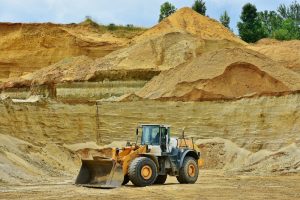
Afghanistan has abundant non-fuel mineral resources. A U.S. 2007 Geological Survey appears to have discovered as much as $3 trillion in mineral deposits in Afghanistan… far beyond previous known reserves, and enough to fundamentally alter the Afghan economy. The previously unknown deposits include “huge veins” of iron, copper, cobalt, gold, and other industrial metals like lithium; Afghanistan could become one of the most important mining centers in the world.
A Pentagon memo stated that Afghanistan might be “the Saudi Arabia of Lithium.” The Ghazni Province may have the world’s largest lithium reserves. Political theorists note these reserves and keen U.S. interest in their control and safekeeping. Currently Chile has the largest proven lithium reserves, followed by Argentina, China, Zimbabwe, Portugal, Brazil, and the United States.
Flash-Charging Electric Buses
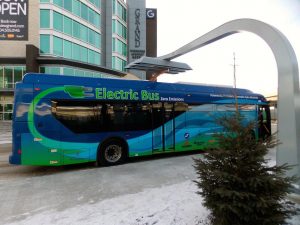
When most of us think of electric buses, we think of heavy buses laden with lots of batteries. But this is not necessarily the case. Imagine topping off a bus’s batteries in 15 seconds and never having to take ebuses out of service for lengthy recharging. That’s the “flash-charging” system being promoted by ABB. It demonstrated its TOSA system in 2013, using specially designed Hess buses in Switzerland. Koreans have developed similar systems.
Launched in 2016 in Switzerland, the flash-charging pilot program serves a bus line between suburban Geneva and the Geneva Airport. Thirteen of its 50 stops have charging technology. While passengers get on and off the bus, an overhead arm connects and the flash charger delivers up to 600 kW for 15 seconds. The system consists of a wayside feeding station, an energy transfer system, and an onboard battery charger. In Geneva, the system has operated for more than 300,000 miles. Another ABB system is now planned for Nantes, France.
To minimize the impacts to the power grid, the ABB charge stations use supercapacitors, also known as ultracapacitors, which fill gradually and store energy… and then release a lot of energy to buses near instantaneously. This flattens out demand on the power grid. It also enables the integration of solar. ABB and King Lion are exporting the technology to China. ABB will provide the fast-charging solution; King Lion will design and assemble the buses.
EVs: A Friend of Mine Asked…
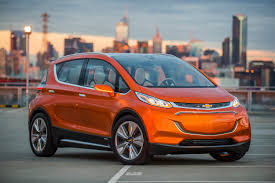
A friend of mine asked, “How much does it cost to operate your electric vehicle?” Well, I thought, it’s the cost of electricity, and since I get mine from the sun, it’s the cost of my solar power. Thanks to federal tax credits and a super rebate from my local municipal utility, my cost for power is 2.8 cents per kilowatt over 25 years!
So how does this stack up? Let’s focus on 100 miles of travel. For my Chevy Bolt that gets 4 miles per kilowatt-hour, I’ll need 25 kWh to handle this trip. That costs me 71 cents in solar cost. If I did not have my own solar system, and had to buy from the grid, I’d still need the same 25 kWh of power, but this time at average rate of 16 cents per kWh… for a cost of $4.00.
Now let’s bring back my beloved Prius and its 50 mile-per-gallon efficiency. The trip would take two gallons. At $3.50 each, that’s two gallons and $7.00. OK, what about a Hummer that gets 14 miles per gallon? That 100-mile trip costs $25, over thirty times the cost of my EV.
So how much do EVs cost? According to the Kelley Blue Book, the average price for a car in 2019 was $37,590. Plug In America’s Electric Vehicle Guide has documented the 40 EVs on the market in its guide. Of those 19 — nine all-electric and 10 plug-in hybrids — have an MSRP that is less than the cost of the average price.
What’s Happening at EcoMotion?
SolSmart Designations
Mission accomplished: EcoMotion has supported seven South Bay Cities Council of Government cities in taking action to be designated SolSmart, three with gold and four with silver. The designations send a clear signal to the solar market that each of these cities welcomes contractors and distributed generation, seeking to reduce soft costs and time-related delays. EcoMotion also helped the COG itself fulfill a regional distinction for which it earned gold.
National Drive Electric Week Kick-Off
Two elevators to the top of LA City Hall. Out at the 26th floor, then up the stairs to the Tom Bradley Tower room on the 27th floor. Panoramic views of Los Angeles. Plug in America’s awards event… there’s a buzz. Secretary Blumenthal speaks, a self-proclaimed, a recent and self-proclaimed EV zealot. He’s right. There is clearly an electric mobility movement… and it’s growing fast. And it feels good.
Capital Group Companies
After a year of planning and preparation, the first construction materials have arrived on site for EcoMotion’s Phase 2 Solar at the Capital Group Companies in Irvine. Six rooftops plus a parking structure will soon be adorned with solar, increasing the solar capacity on campus from 1 MW to 2.6. MW. The additional solar was enabled by a change in Southern California Edison interconnection rules.
48-Campus Solar in Chula Vista
Chula Vista Elementary School District officials were pleased with the results of EcoMotion’s 48-campus solar feasibility analysis. The solar team determined that every location is cost-effective for solar, potentially saving the district $60 – 90 million over 25 years. Now EcoMotion has the green light to take the project to market, finalizing the scope of work and shopping it out to suitable contractors requesting cash and PPA pricing. In related news, EcoMotion has been selected by the Del Mar Unified School District as its solar consultant.
Moderating the Westside Urban Forum
Ted Flanigan was asked to moderate a panel of building standards and codes experts for the Westside Urban Forum in Culver City. The title of the talk, “Will the Updated California Building Code Foster Sustainable Development?” was intriguing. Yes, but no so fast… Ratcheting standards higher, cost effectively, is complex. Codes stretch as innovation drives efficiency. Panelists included Osama Younan, Executive Officer of the City of Los Angeles Building and Safety. Also on the panel were experts from Frederick Fisher and Partners, Integral Group, and Hudson Pacific Properties.
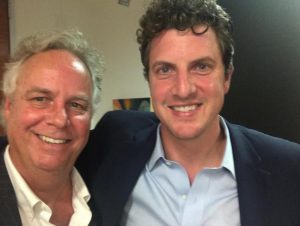
A Fireside Chat with Senator Henry Stern
The Young Professionals in Energy asked Ted Flanigan to host a fireside chat with California State Senator Henry Stern. High in Century City, hosted by a law firm, there was no fireplace… instead glorious views of the west side and the Pacific Ocean, shimmering as the sun set. Stern is young, enthusiastic, and a force for the environment in the California State Senate. A former assistant to Senator Fran Pavley, a surfer from Malibu, Stern is now an energy and environmental policy leader in California. We talked renewables, storage, resiliency, carbon-cutting policies, and microgrid tariffs.

Striking for Climate in Los Angeles
The accolades for 16-year old, Swedish student, Greta Thunberg ought to be endless… some 4,000 strikes in 169 countries. That’s a major accomplishment. In LA, the EcoMotion team hit the streets, welcomed by a teenager with a megaphone inviting adults to support the student strike. Shaun Miller brought his family. There is no planet B.
Wishing Michele Well…
Finally, our team wishes Michele Baldi farewell. A terrific colleague for over three years who made many valuable contributions at EcoMotion, Michele has elected to pursue a career as a personal trainer. She is talented, fun, and will certainly thrive in her new position. While sorry to see her go, the EcoMotion team wishes her well!









